Electronics and Communication Engineering (ECE) Exam > Electronics and Communication Engineering (ECE) Questions > A circuit with an ideal OPAMP is shown. The ...
Start Learning for Free
A circuit with an ideal OPAMP is shown. The Bode plot for the magnitude (in dB) of the gain transfer function  of the circuit is also provided (here, ω is the angular frequency in rad/sec). The values of R and C are
of the circuit is also provided (here, ω is the angular frequency in rad/sec). The values of R and C are
 of the circuit is also provided (here, ω is the angular frequency in rad/sec). The values of R and C are
of the circuit is also provided (here, ω is the angular frequency in rad/sec). The values of R and C are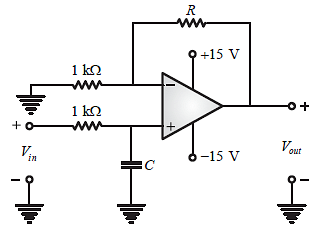
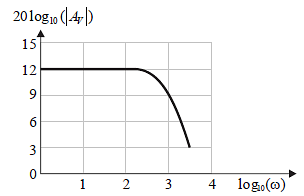
- a)R = 3kΩ, C = 1μF
- b)R = 3kΩ, C = 2μF
- c)R = 1kΩ, C = 3μF
- d)R = 4kΩ, C = 1μF
Correct answer is option 'A'. Can you explain this answer?
| FREE This question is part of | Download PDF Attempt this Test |
Most Upvoted Answer
A circuit with an ideal OPAMP is shown. The Bode plot for the magnitu...
The given Op-Amp circuit is shown below,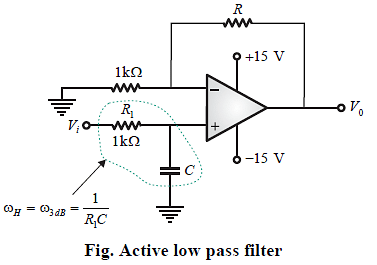
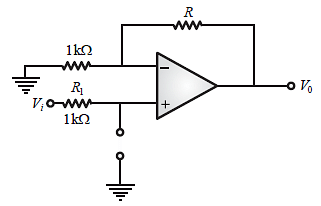


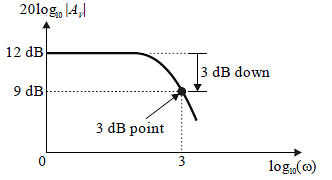


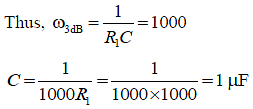

The given Op-Amp circuit is first order active low pass filter, so low frequency (ω = 0) gain of given low pass filter is,

The above Op-Amp circuit becomes as non-inverting closed loop Op-Amp, so gain (AV) is,

The 3-dB cut-off frequency of given low pass filter circuit is,

According to given bode magnitude plot,

Low frequency (ω = 0) gain from bode magnitude plot is,
12dB = 20log10 (AV)

1+ R = 4
R = 3 kΩ
The 3-dB frequency from bode magnitude plot,


Hence, the correct option is (A).
Free Test
FREE
| Start Free Test |
Community Answer
A circuit with an ideal OPAMP is shown. The Bode plot for the magnitu...
The given Op-Amp circuit is shown below,








The given Op-Amp circuit is first order active low pass filter, so low frequency (ω = 0) gain of given low pass filter is,

The above Op-Amp circuit becomes as non-inverting closed loop Op-Amp, so gain (AV) is,

The 3-dB cut-off frequency of given low pass filter circuit is,

According to given bode magnitude plot,

Low frequency (ω = 0) gain from bode magnitude plot is,
12dB = 20log10 (AV)

1+ R = 4
R = 3 kΩ
The 3-dB frequency from bode magnitude plot,


Hence, the correct option is (A).
Attention Electronics and Communication Engineering (ECE) Students!
To make sure you are not studying endlessly, EduRev has designed Electronics and Communication Engineering (ECE) study material, with Structured Courses, Videos, & Test Series. Plus get personalized analysis, doubt solving and improvement plans to achieve a great score in Electronics and Communication Engineering (ECE).

|
Explore Courses for Electronics and Communication Engineering (ECE) exam
|

|
Similar Electronics and Communication Engineering (ECE) Doubts
A circuit with an ideal OPAMP is shown. The Bode plot for the magnitude (in dB) of the gain transfer function of the circuit is also provided (here, ω is the angular frequency in rad/sec). The values of R and C are a)R = 3kΩ, C = 1μFb)R = 3kΩ, C = 2μFc)R = 1kΩ, C = 3μFd)R = 4kΩ, C = 1μFCorrect answer is option 'A'. Can you explain this answer?
Question Description
A circuit with an ideal OPAMP is shown. The Bode plot for the magnitude (in dB) of the gain transfer function of the circuit is also provided (here, ω is the angular frequency in rad/sec). The values of R and C are a)R = 3kΩ, C = 1μFb)R = 3kΩ, C = 2μFc)R = 1kΩ, C = 3μFd)R = 4kΩ, C = 1μFCorrect answer is option 'A'. Can you explain this answer? for Electronics and Communication Engineering (ECE) 2024 is part of Electronics and Communication Engineering (ECE) preparation. The Question and answers have been prepared according to the Electronics and Communication Engineering (ECE) exam syllabus. Information about A circuit with an ideal OPAMP is shown. The Bode plot for the magnitude (in dB) of the gain transfer function of the circuit is also provided (here, ω is the angular frequency in rad/sec). The values of R and C are a)R = 3kΩ, C = 1μFb)R = 3kΩ, C = 2μFc)R = 1kΩ, C = 3μFd)R = 4kΩ, C = 1μFCorrect answer is option 'A'. Can you explain this answer? covers all topics & solutions for Electronics and Communication Engineering (ECE) 2024 Exam. Find important definitions, questions, meanings, examples, exercises and tests below for A circuit with an ideal OPAMP is shown. The Bode plot for the magnitude (in dB) of the gain transfer function of the circuit is also provided (here, ω is the angular frequency in rad/sec). The values of R and C are a)R = 3kΩ, C = 1μFb)R = 3kΩ, C = 2μFc)R = 1kΩ, C = 3μFd)R = 4kΩ, C = 1μFCorrect answer is option 'A'. Can you explain this answer?.
A circuit with an ideal OPAMP is shown. The Bode plot for the magnitude (in dB) of the gain transfer function of the circuit is also provided (here, ω is the angular frequency in rad/sec). The values of R and C are a)R = 3kΩ, C = 1μFb)R = 3kΩ, C = 2μFc)R = 1kΩ, C = 3μFd)R = 4kΩ, C = 1μFCorrect answer is option 'A'. Can you explain this answer? for Electronics and Communication Engineering (ECE) 2024 is part of Electronics and Communication Engineering (ECE) preparation. The Question and answers have been prepared according to the Electronics and Communication Engineering (ECE) exam syllabus. Information about A circuit with an ideal OPAMP is shown. The Bode plot for the magnitude (in dB) of the gain transfer function of the circuit is also provided (here, ω is the angular frequency in rad/sec). The values of R and C are a)R = 3kΩ, C = 1μFb)R = 3kΩ, C = 2μFc)R = 1kΩ, C = 3μFd)R = 4kΩ, C = 1μFCorrect answer is option 'A'. Can you explain this answer? covers all topics & solutions for Electronics and Communication Engineering (ECE) 2024 Exam. Find important definitions, questions, meanings, examples, exercises and tests below for A circuit with an ideal OPAMP is shown. The Bode plot for the magnitude (in dB) of the gain transfer function of the circuit is also provided (here, ω is the angular frequency in rad/sec). The values of R and C are a)R = 3kΩ, C = 1μFb)R = 3kΩ, C = 2μFc)R = 1kΩ, C = 3μFd)R = 4kΩ, C = 1μFCorrect answer is option 'A'. Can you explain this answer?.
Solutions for A circuit with an ideal OPAMP is shown. The Bode plot for the magnitude (in dB) of the gain transfer function of the circuit is also provided (here, ω is the angular frequency in rad/sec). The values of R and C are a)R = 3kΩ, C = 1μFb)R = 3kΩ, C = 2μFc)R = 1kΩ, C = 3μFd)R = 4kΩ, C = 1μFCorrect answer is option 'A'. Can you explain this answer? in English & in Hindi are available as part of our courses for Electronics and Communication Engineering (ECE).
Download more important topics, notes, lectures and mock test series for Electronics and Communication Engineering (ECE) Exam by signing up for free.
Here you can find the meaning of A circuit with an ideal OPAMP is shown. The Bode plot for the magnitude (in dB) of the gain transfer function of the circuit is also provided (here, ω is the angular frequency in rad/sec). The values of R and C are a)R = 3kΩ, C = 1μFb)R = 3kΩ, C = 2μFc)R = 1kΩ, C = 3μFd)R = 4kΩ, C = 1μFCorrect answer is option 'A'. Can you explain this answer? defined & explained in the simplest way possible. Besides giving the explanation of
A circuit with an ideal OPAMP is shown. The Bode plot for the magnitude (in dB) of the gain transfer function of the circuit is also provided (here, ω is the angular frequency in rad/sec). The values of R and C are a)R = 3kΩ, C = 1μFb)R = 3kΩ, C = 2μFc)R = 1kΩ, C = 3μFd)R = 4kΩ, C = 1μFCorrect answer is option 'A'. Can you explain this answer?, a detailed solution for A circuit with an ideal OPAMP is shown. The Bode plot for the magnitude (in dB) of the gain transfer function of the circuit is also provided (here, ω is the angular frequency in rad/sec). The values of R and C are a)R = 3kΩ, C = 1μFb)R = 3kΩ, C = 2μFc)R = 1kΩ, C = 3μFd)R = 4kΩ, C = 1μFCorrect answer is option 'A'. Can you explain this answer? has been provided alongside types of A circuit with an ideal OPAMP is shown. The Bode plot for the magnitude (in dB) of the gain transfer function of the circuit is also provided (here, ω is the angular frequency in rad/sec). The values of R and C are a)R = 3kΩ, C = 1μFb)R = 3kΩ, C = 2μFc)R = 1kΩ, C = 3μFd)R = 4kΩ, C = 1μFCorrect answer is option 'A'. Can you explain this answer? theory, EduRev gives you an
ample number of questions to practice A circuit with an ideal OPAMP is shown. The Bode plot for the magnitude (in dB) of the gain transfer function of the circuit is also provided (here, ω is the angular frequency in rad/sec). The values of R and C are a)R = 3kΩ, C = 1μFb)R = 3kΩ, C = 2μFc)R = 1kΩ, C = 3μFd)R = 4kΩ, C = 1μFCorrect answer is option 'A'. Can you explain this answer? tests, examples and also practice Electronics and Communication Engineering (ECE) tests.

|
Explore Courses for Electronics and Communication Engineering (ECE) exam
|

|
Suggested Free Tests
Signup for Free!
Signup to see your scores go up within 7 days! Learn & Practice with 1000+ FREE Notes, Videos & Tests.
























